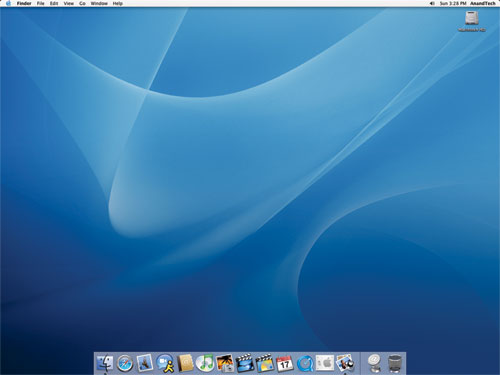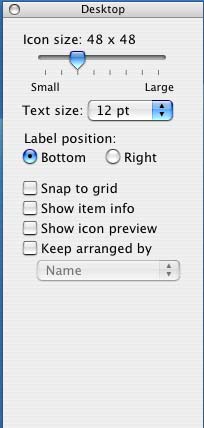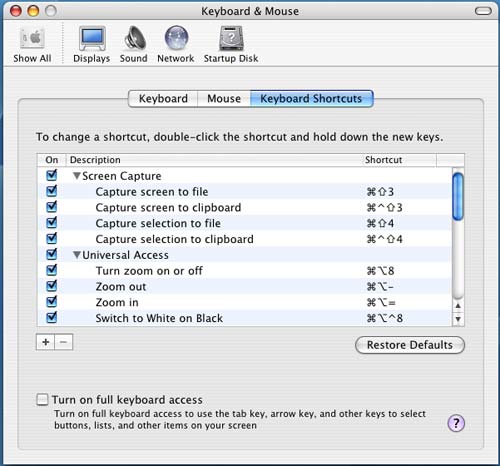A Month with a Mac: A Die-Hard PC User's Perspective
by Anand Lal Shimpi on October 8, 2004 12:05 AM EST- Posted in
- Mac
Finding my way around Finder
The OS X desktop is clearly different from what I was used to under XP. For starters, all of the icons have been moved to the right side of the screen; and where I was used to seeing a taskbar, there was this little translucent "dock" with a bunch of icons in it.
The OS X desktop and features, such as icon size, dock size and animations, are easily customizable.
Click to enlarge.
Under Windows, there is Explorer. It is the application that not only exists as a way of browsing your file system, but also as the "desktop" itself; the OS X equivalent? Finder. I don't think that I have to point out the similarity in the names. Yes, one company copied (or poked fun at) another.
My first reaction was that the icons on the desktop were far too large; indeed, they are, if you put them on a Windows desktop - but for some reason, they end up looking strange if you make them smaller. One of the biggest features of OS X is the ability to customize just about every aspect of the OS; I didn't like the size of the icons at first, so I simply changed the icon size through the "view options" menu. Although it's easy to talk about now, I had to ask how to do it online before I ever discovered the option - also the case with the majority of OS X, most of the power and customization of the OS remains hidden. I quickly realized that although Apple had targeted the entry level computer user with the interface of OS X, the OS was far more tailored to the power user in my opinion.

Where to start? Customization is much more possible (and easy to do) under OS X than any variant of Windows that I have ever encountered. Icon sizes are just the beginning; through the view options menu alone, you can change the positioning of the labels on the icons, the text size as well as the normal array of Windows options. And any changes you make here occur in real time - no clicking "OK" or "Apply". Just check a box and it happens instantaneously; and uncheck it, and everything goes back to normal. It's a small thing, but as I soon found out, much of OS X's appeal to me came in tiny gems like this.
The other thing to point out, which is quite possibly the biggest draw to OS X for me, is the fact that just about everything under OS X has a keyboard shortcut associated with it. I've found that if you got your start with PCs in the DOS days, then you end up being much more of a keyboard junkie than someone who is reliant on the mouse. I use the mouse when I have to, but when it's quicker to use the keyboard, I feel much more comfortable firing off a few keystroke combinations to get my point across. If you are anything like me in that respect, then OS X will be your playground.
I can't possibly list all of the keystroke combinations that I use on a daily basis, but there are quite a few. For example, I am a big "ALT-TAB"-er in Windows, but ALT-TAB is only really useful for switching applications, not closing them. The ALT-TAB equivalent under OS X, Command-TAB (the Command key is positioned where you'd expect ALT to be, so it works out fine), works similarly, but here's the catch - hit "Q" while you've selected an application and it will quit automatically. Nice, but nothing major right?
Want to minimize a window? Command-M will take care of that. Want to hide an application without minimizing it? Command-H. Hidden windows will automatically move to the end of the Command-TAB list, so you don't switch to them after you've hidden them.
Want to open a new Finder window? Command-N. Want to create a new folder on your drive? Shift-Command-N. I've always wanted to be able to create new folders in Explorer without using the mouse. OS X was a dream come true in that respect.
OS X will even let you define your own keyboard shortcuts for any application through the keyboard preferences panel:

Not impressed? Not a keyboard junkie? Then Finder is just as capable and as usable as Explorer. No big win for Apple there, but maybe a draw. For me, the little things are what intrigued me, but I'll admit - not everyone is as easily amused!
There is one aspect of the keyboard shortcut support that OS X does fall behind on, and that is support for keyboard shortcuts in dialog boxes. In some dialog boxes, hitting Command and the letter of the option you want to select will work, but in others, it will not. Furthermore, finding out the correct key to hit to select the option that you want is most definitely a guessing game, as there are no underlined characters or anything indicating what key to hit. Given OS X's strong support for keyboard shortcuts, this shortcoming (no pun intended) is puzzling.










215 Comments
View All Comments
vladik007 - Thursday, March 31, 2005 - link
" highly paid Windows admin / Cisco Engineer "geeez ... new low bottom.
MarshallG - Monday, February 28, 2005 - link
I was thinking about getting a Mini Mac. But with a 1.25 GHz CPU, it's about 1/4 the machine that Anand tested.Will I be disapointed by its performance at the same kinds of tasks Anand mentioned? I realize that I'll have to upgrade to maybe 1 GB of RAM.
BikeMike - Sunday, January 30, 2005 - link
re: OSX dialogue keyboard shortcuts - like in Word, where 'd' means 'don't save' and 'return' & 'enter' apply to the highlighted button, many OSX apps do not require a modifier key, such as 'alt' or 'command'. The experience of discovery is guesswork, yes, but if you don't look for a modifier key, you get better at guessing. For example, in iTunes dialogues, 'y' means, you guessed it, 'yes'.pyramiddown - Saturday, January 29, 2005 - link
Ctrl-Tab to switch tabs in FirefoxOmnisAudis - Wednesday, January 26, 2005 - link
Great article! very long winded, but awesome. I am a long time Mac user, with an XP machine at home and an iBook at work.I thought it was very interesting you found nothing snazzy about iCal. It is my FAV Apple app!! It is the most powerful, easy to use calendar I've come across. And it seems to be able to do things that XP Outlook can't. For one thing, I can publish a calendar so that other users can subsribe to it. When I make a change to that calendar, they see those changes.
I can have TONS of calendars. In outlook, my boss can only have one (and view others). At my work place, we have 20 productions going on. It would be great if he could generate a calander that we could subscribe to for each show. As changes occur, we would get them without a memo going out, and everyone updating their calendars.
Plus, I can subscribe to a season calendar of the Yankees! So as I publish calendars for visiting artists, and I subscribe to one for entertainment.
I'll stop now. But I think you should revist iCal. Look at it from a multi-user point of view.
Thanks for the objective article. I've learned a few things about OS-X!
KingKuei - Sunday, January 16, 2005 - link
Anand,Wait til you see Tiger...
Updated Safari with significantly improved speed and capabilities.
Add the Spotlight feature (comprehensive demo at MacWorld Expo --> don't miss the jab at Bill Gates when the Spotlight feature crashes... one word: backup)
Dashboard (sorry to the company that made it, but the feature is coming free to Tiger and I can't wait!)
And for the first time, fully takes advantage of the 64-bit processing core of the G5.
Anand, I dare you to write a follow-up review on that dual-2Ghz of your's when Tiger ships ON SCHEDULE later this year!
macgeek - Saturday, January 1, 2005 - link
It is go glaringly obvious to any Mac user that you did understand half of what you were writing about. Just a few glaring omissions from your article:* Unix-based, and you have full control of Unix through the terminal.
* No spyware or viruses - I don't even run anti-virus because there has NEVER been a virus for OS X. NOT ONE!!!
* Why do you think Office 2004 sucks? Probably because it's made by Microsoft! Ever heard of OpenOffice?
* Address Book - not only is it integrated into mail, but it's integrated into OS X.
* Guess you didn't spend much time looking for it, because you could have had Trillian for Mac OS X as well.
* Browsers - Yeah, Safari needs some work, but you've got quite a few to choose from. Oh, and Safari isn't the Lincoln Tunnel of security holes that IE is either. And if you so choose, you can simply drag Safari to the trash can and never use it again. Now try that with IE.
* ipfw vs. Windows Firewall - Puuhhlleeeeasseee!! What does microsoft give you? A firewall that a third-grader could get through and that allows EVERYTHING OUT!!!!! I quite like having the ability to customize ipfw in terminal to have a firewall that is truly an industrial strength firewall.
* Root authentication - whenever a program needs to install or modify system files, you have to authenticate as root. Too bad that when you're logged on as an Admin in Windows it's "anything goes" and you have no choice when that nasty website throws a dll file into the Windows directory.
* No mention of any Apple Pro Apps like Final Cut HD. I've seen what happens to P4 systems when they try to render video in Adobe Premiere - they crash. You have to drop at least an extra $1000 for a Canopus or high-end Matrox capture card to have a chance of competing with a dual G5 system. My PowerBook G4 1.5 GHz renders video better than my P4 3.4 with 1GB of HyperX PC3500.
* No mention of integrated Bluetooth, or how simple it is to configure networking, or of integrated Firewire 800.
Shoddy research, and a poor attempt overall. It's easy to see that you liked the G5, but you didn't even scratch the surface before you wrote that article. And if you honestly think that OS X crashes as much as Windows, you REALLY must not have known what you were doing.
And I qualify this as my day job is as a highly paid Windows admin / Cisco Engineer. I know Windows XP / 2k / 2k Server and Win2k3 inside and out, and they can't touch the possibilities of OS X. The only area that I'll give you is gaming. That's why I have a top-o-the-line AMD.
hopejr - Monday, November 8, 2004 - link
I'm quite impressed with this article. I'm a recent switcher (august 04) and can say that I much rather OS X to any other OS that I've used (every single released version of windows from 1.03 to Longhorn 4074, many Linux distros, and mac os from system 6 to OS X Panther).I didn't go for a beefed up PowerMac G5, but I did buy a 12" iBook G4 with student discount (April 04 model). I've found that these are the cheapest decent notebooks out (as I can't stand celerons :P), and for a 12" at just AU$1520, I think it was a bargain (most PC 12" laptops are twice that much with almost identical specs).
I also like the fact that I have seemless networking with my Windows machines. Another thing I like is that I can do all the stuff I need to do on linux (for University) on my iBook because of its unix base.
In regard to the point someone made (i can't remember which post) about this article testing multitasking on a dual processor environment, I find that my single processor G4 laptop is still much better at multitasking than the latest Windows PC with hyperthreading, or even an AMD64, that I've used. Maybe that's just me though :P.
I've found that I'm more productive on OS X compared to windows, especially with all those keyboard shortcuts.
BTW, post #207 is right about the choice mac users have to make, I make those choices now, and know exactly when I want a program to close, or when I just want to close a window. I also find command-H and command-option-H very useful with reducing screen clutter.
I haven't always liked Macs. I hated them mainly because the classic OS was a pain to use in my opinion with little control over it (I am a DOS user, so I like being in control of my machine using a command prompt). When OS X came out (especially Panther), my hatred disappeared.
macgruder - Saturday, November 6, 2004 - link
Pretty good and fair review.I wish people would stop saying an App should quit when you close the last window. This is not useful in many situations. e.g. I'm in Photoshop, I have a window open, and I'm done with it, but am going to continue working. Close the windows, oops Photoshop quits.
Mac users are used to making the following choice:
a. I want to close a window (command-W)
b. I want to quit the App. (command-Q)
These are 2 distinct actions. To me closing a window is just that, and shouldn't be connected to the independent action of quitting an app. If I'm done and I have ten windows open, I just command-Q, and the windows(if not saved) close automatically anyway. As far as I can see Windows seems to be forcing you (correct me if I'm wrong) to do an unconnected action, when you may not want to.
Humancodex - Friday, November 5, 2004 - link
I make a link of the article to: http://www.macbidouille.com (french) in forum "switch", everybody like your "objectivité", and like you to push the Mac test trial more often!